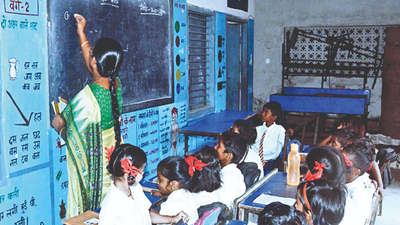Top Searches
- News
- City News
- ranchi News
- 86% of Class III kids unable to read Class II books: Annual Status of Education Report in Jharkhand
86% of Class III kids unable to read Class II books: Annual Status of Education Report in Jharkhand

Since 2018, fewer students of Class III can read Class II books and the number of students with proficient reading skills has fallen in 2022
RANCHI: Around 86% of Class III students in Jharkhand schools are unable to read sentences and words from Class II textbooks, the latest Annual Status of Education Report (Aser) has said.
The survey covered 28,196 pupils between the age group of three and 16 from 720 villages of all 24 districts in the state.
According to the report, there has been a decline in the students’ reading abilities. In 2022, around 86% of Class III students were unable to recognise words or read sentences from the Class II-level textbooks. Since 2018, fewer students of Class III can read Class II reading materials and the number of students with proficient reading skills has fallen in 2022, the report said.
The report indicates a decrease of 4.5 % in the reading abilities of the students in comparison with 2018. Around 18.7% of Class III students were able to read a Class II text in 2018, but by 2022, that number decreased to 14.2%.
Similarly, Class VIII students’ reading skills have also dropped. The report said around 34% of Class VIII students in the state lack fundamental reading skills and cannot read the sentences and do not understand the content of the phrases. Only 65.1% of Class VIII students can read sentences and comprehend their meaning. Overall, in 2022, the basic reading proficiency of schoolchildren has decreased to 65.1% from 66.1% in 2018.
In 2012 report data, 14.5% of pupils were able to read without difficulty. In 2016, this number had risen to 16.2 %.
Meanwhile, there has been a slight improvement in the reading abilities of Class V students. In 2018, 34.3% of the Class V students were able to read texts and by 2022, this percentage climbed to 35.6%.
Teachers also admitted that there is a learing gap among the students and attributed it to the Covid-19 pandemic.
Nashim Ahmed, the principal of Government Middle School, Bariatu, said, “As a result of the Covid-19 pandemic, pupils have lost the ability to read and recognise words. To counteract this, the government has provided Foundation Learning and Numeracy Books and Gyansetu Books, which are designed to eliminate the learning gaps. The effectiveness of the books in bridging the learning gap is fairly high.”
The survey covered 28,196 pupils between the age group of three and 16 from 720 villages of all 24 districts in the state.
According to the report, there has been a decline in the students’ reading abilities. In 2022, around 86% of Class III students were unable to recognise words or read sentences from the Class II-level textbooks. Since 2018, fewer students of Class III can read Class II reading materials and the number of students with proficient reading skills has fallen in 2022, the report said.
The report indicates a decrease of 4.5 % in the reading abilities of the students in comparison with 2018. Around 18.7% of Class III students were able to read a Class II text in 2018, but by 2022, that number decreased to 14.2%.
Similarly, Class VIII students’ reading skills have also dropped. The report said around 34% of Class VIII students in the state lack fundamental reading skills and cannot read the sentences and do not understand the content of the phrases. Only 65.1% of Class VIII students can read sentences and comprehend their meaning. Overall, in 2022, the basic reading proficiency of schoolchildren has decreased to 65.1% from 66.1% in 2018.
In 2012 report data, 14.5% of pupils were able to read without difficulty. In 2016, this number had risen to 16.2 %.
Meanwhile, there has been a slight improvement in the reading abilities of Class V students. In 2018, 34.3% of the Class V students were able to read texts and by 2022, this percentage climbed to 35.6%.
Teachers also admitted that there is a learing gap among the students and attributed it to the Covid-19 pandemic.
Nashim Ahmed, the principal of Government Middle School, Bariatu, said, “As a result of the Covid-19 pandemic, pupils have lost the ability to read and recognise words. To counteract this, the government has provided Foundation Learning and Numeracy Books and Gyansetu Books, which are designed to eliminate the learning gaps. The effectiveness of the books in bridging the learning gap is fairly high.”
Start a Conversation
FOLLOW US ON SOCIAL MEDIA
FacebookTwitterInstagramKOO APPYOUTUBE










